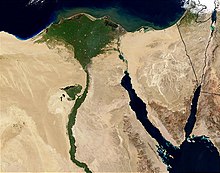Blue Nile[edit]
Main article: Blue Nile
The Blue Nile (Ge'ez ጥቁር ዓባይ Ṭiqūr ʿĀbbāy (Black Abay) to Ethiopians; Arabic: النيل الأزرق; transliterated: an-Nīl al-Azraq) springs from Lake Tana in the Ethiopian Highlands. The Blue Nile flows about 1,400 kilometres to Khartoum, where the Blue Nile and White Nile join to form the Nile. Ninety percent of the water and ninety-six percent of the transported sediment carried by the Nile[25] originates in Ethiopia, with fifty-nine percent of the water from the Blue Nile (the rest being from the Tekezé, Atbarah, Sobat, and small tributaries). The erosion and transportation of silt only occurs during the Ethiopian rainy season in the summer, however, when rainfall is especially high on the Ethiopian Plateau; the rest of the year, the great rivers draining Ethiopia into the Nile (Sobat, Blue Nile, Tekezé, and Atbarah) have a weaker flow.
The flow of the Blue Nile varies considerably over its yearly cycle and is the main contribution to the large natural variation of the Nile flow. During the dry season the natural discharge of the Blue Nile can be as low as 113 m3/s (4,000 cu ft/s), although upstream dams regulate the flow of the river. During the wet season the peak flow of the Blue Nile often exceeds 5,663 m3/s (200,000 cu ft/s) in late August (a difference of a factor of 50).
Before the placement of dams on the river the yearly discharge varied by a factor of 15 at Aswan. Peak flows of over 8,212 m3/s (290,000 cu ft/s) occurred during late August and early September, and minimum flows of about 552 m3/s (19,500 cu ft/s) occurred during late April and early May.
Bahr el Ghazal and Sobat River[edit]
The Bahr al Ghazal and the Sobat River are the two most important tributaries of the White Nile in terms of discharge.
The Bahr al Ghazal's drainage basin is the largest of any of the Nile's sub-basins, measuring 520,000 square kilometers (200,000 sq mi) in size, but it contributes a relatively small amount of water, about 2 m3/s (71 cu ft/s) annually, due to tremendous volumes of water being lost in the Sudd wetlands.
The Sobat River, which joins the Nile a short distance below Lake No, drains about half as much land, 225,000 km2 (86,900 sq mi), but contributes 412 cubic meters per second (14,500 cu ft/s) annually to the Nile.[26] When in flood the Sobat carries a large amount of sediment, adding greatly to the White Nile's color.[27]



No comments:
Post a Comment